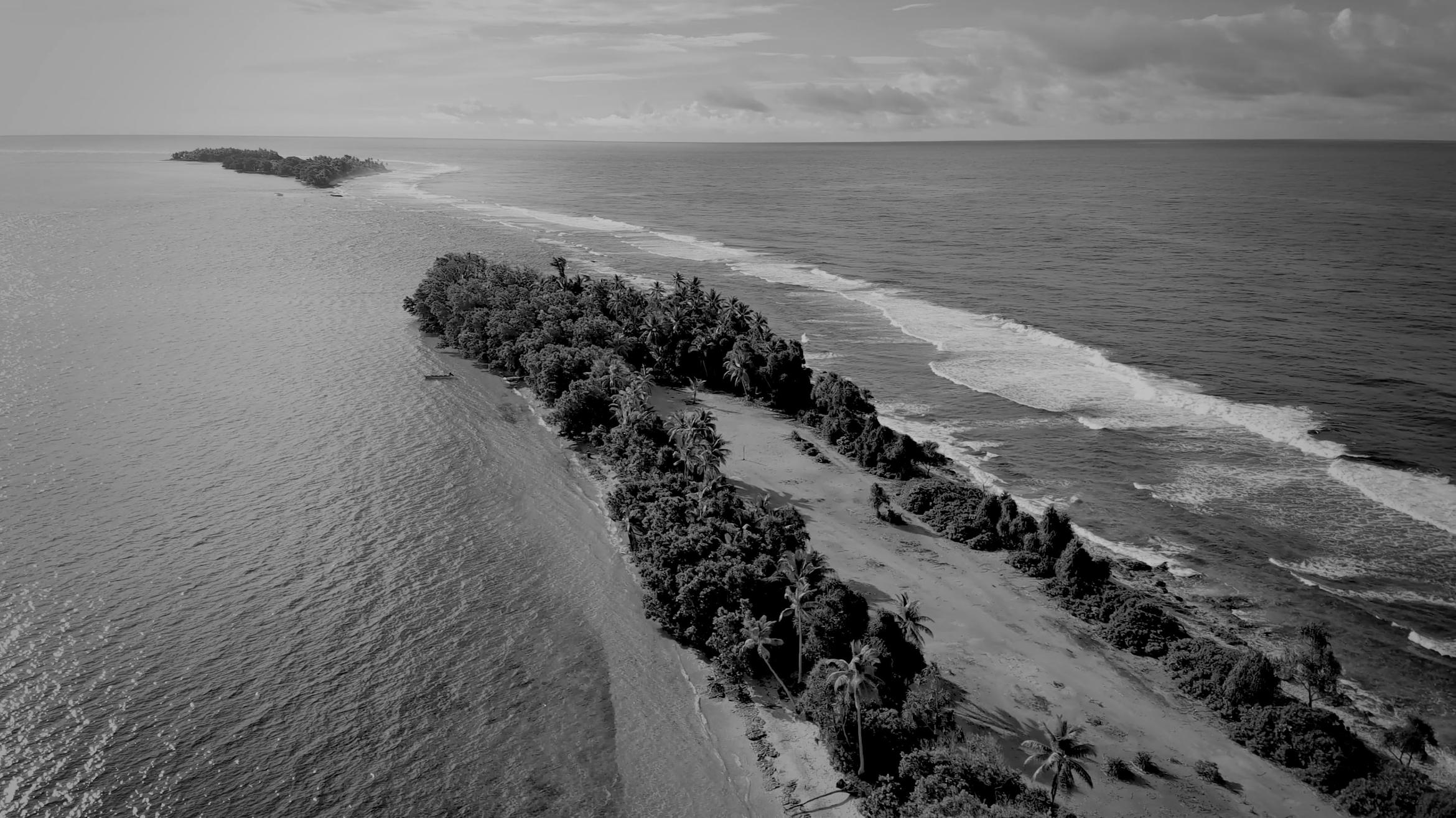Ultimately, He Whakaputanga Moana is a declaration for future generations. Our mokopuna (descendants) deserve to inherit an ocean teeming with life, where the songs of whales continue to resonate across the vast expanse. … Let this declaration be a turning point. Let us ensure the whales, our kin, our pouwhenua (guiding posts), continue their migrations for generations to come. Kia ora, kia kaha! (Be well, be strong!)
As Matariki/Mataliki rises in the southwest Pacific, it signals renewal and reconnection. Matariki is a compass guiding us through cyclical, relational time—time that unfurls across generations, land, and sea. For Tangata Moana, the ocean is an ancestor. Through the work of Pacific artists, rangatahi, poets, and legal thinkers, the ocean is increasingly recognised globally as a sovereign being. Aotearoa-born Nanumean artist Vailahi Vailahi explores this living relationship in his immersive practice, where virtual reality becomes a vessel to honour ancestral ties to land and sea, and to preserve the stories of a community shaped by the ocean. This essay situates Vailahi’s work alongside the climate justice efforts of young people across the Pacific, the practice of artist Martha Atienza, and the poetry of Audrey Brown-Pereira, to highlight the growing movement for Pacific reclamation, Indigenous data sovereignty, and Indigenous-led environmental justice.
Across the Pacific, rangatahi are demanding accountability through initiatives like the 'Pacific Islands Students Fighting Climate Change' campaign, which successfully lobbied for the UN General Assembly to request an advisory opinion from the International Court of Justice on member states' legal obligations to mitigate climate harm.(1) Mobilising international law as a tool for Indigenous futurity, these students insist that climate change is a matter of intergenerational justice and global responsibility. As part of this movement, participants have engaged in actions grounded in Indigenous knowledge systems and environmental restoration. In Tuvalu, as part of this campaign, youth activists have helped replant coastal trees to prevent erosion, collaborated with elders to document oral histories of past climate patterns, and integrated traditional ecological knowledge with scientific research to map the impacts of rising tides. Many advocate strengthening climate resilience from within, by repairing sea walls, using sustainable building materials, and restoring customary food systems to ensure survival under worsening climate conditions. Projects such as the Tuvalu Coastal Adaptation Project (TCAP) merge science, traditional knowledge, and digital tools to address coastal erosion and sea level rise.(2) This work represents a new wave of Pacific climate leadership, deeply rooted in ancestral knowledge, community care, and a refusal to be passive victims of planetary collapse. Tuvaluan scientist Lamese Saamu affirms the importance of place-based knowledge in this struggle, saying: "I plan to use my skills in island morphology to build the resilience of coastal island communities in Tuvalu and the Pacific."(3) Here, the concept of 'island morphology' refers not only to the mapping of sand and reef but also that of the shapes of memory, story, and the contours of belonging.
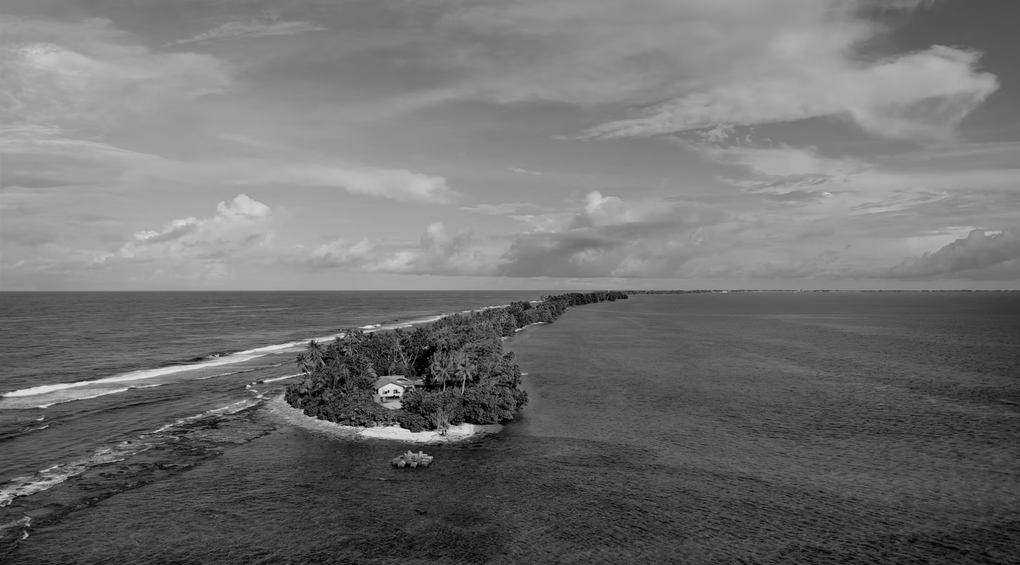
Vailahi Vailahi, Drone footage of Nanumea and Funafuti (2025)
In November 2021, Tuvalu’s then-Minister of Justice and Foreign Affairs, Simon Kofe, stood knee-deep in seawater to deliver his address to COP26, the annual United Nations (UN) Climate Conference which had convened that year in Glasgow, Scotland. Filmed from the shoreline of Funafuti, his message was direct: "We are sinking."(4) Kofe called for urgent international action and proposed a radical idea: if Tuvalu could not be physically preserved, it might be digitally archived. Kofe's idea of a "digital twin" of Tuvalu was not only technological, but philosophical.
Within this context of urgency and digital speculation, Aotearoa-born Nanumean artist Vailahi Vailahi began the Master of Design Innovation course at Te Herenga Waka—Victoria University of Wellington. For his thesis research, Vailahi returned to his ancestral island of Nanumea to speak with elders, digitally scan sacred sites, and begin constructing a virtual reality (VR) environment that could hold cultural memory in the face of rising tides. The result, a project titled 'VR Talatala mai Nateaho (Sharing Ancient Stories),' weaves video, photogrammetry, spatial audio, and digital drawing into a speculative archive of Nanumean knowledge. Central to the project are high-resolution digital models of two significant communal spaces: the Lotolelei Church and the Aahiga cultural meeting house. In virtual space, these sites are re-animated as vessels of oral transmission, spiritual life, and collective governance. Rather than simulating a static past, Vailahi’s VR environments invite relational encounters where digital sovereignty becomes a form of cultural continuity. These spatial re-mappings of Nanumea embody a kind of digital morphology, acknowledging the shifting contours of land, story, and belonging while offering a model for Indigenous innovation and environmental stewardship.
Drone Footage of Nanumea and Funafuti
Vailahi’s practice emerges within a whakapapa of Indigenous artists who use video as a vessel for spirituality, environmental witness, and cultural continuity. In Our Islands 11°16’58.4” 123°45’07.0” (2017), Dutch-Filipino artist Martha Atienza presents a surreal yet grounded vision of life on Bantayan Island in the Philippines. Members of the local fishing community perform a religious procession underwater through what were once village streets. By restaging a land-based ritual beneath rising waters, Atienza underscores the urgency of climate change, while holding space for humour, beauty, and reverence. Where in her earlier work, Atienza documented the lives of fishermen including her father, her practice has since evolved alongside her growing environmental concerns, shifting toward collaborative, community-led forms of knowledge-making. Our Islands affirms the cultural sovereignty of Bantayan through art that is both archival and adaptive. Similarly, Vailahi’s work in moving image draws from Moana knowledge systems that were recounted to him by his elders, invoking ancestral presence and ceremony to imagine Tuvaluan futures. His spatial storytelling carries memory and mana, offering continuity amid loss. Seen alongside his VR practice, these works are not simply about documenting change—they are living expressions of Indigenous resilience, innovation, and intergenerational care.
Drone Footage of Nanumea and Funafuti (2025) is a 7-minute black-and-white film offering a bird’s-eye view of Tuvalu’s atolls through sweeping aerial drone footage. Vailahi embraces this technology as a powerful tool for cultural continuity, part of his wider practice grounded in documenting, archiving, and celebrating the living heritage of Nanumea. From above, the island is revealed not as a disappearing place, but as an interconnected community of homes. The monochrome palette resists the aesthetics of tropical tourism, directing the viewer’s attention to proximity, scale, and risk. Most of this land hovers just one to two metres above sea level. The drone footage reveals how houses cling to the narrow land, sometimes only just separated from the ocean on either side. The camera’s flight path follows a choreography of tension between presence and disappearance. In one scene, a line of palm trees marks the shore. Here, they are not symbols of leisure but guardians of the coastline. The coconut tree holds cultural and practical value; their repetition across the landscape signals intergenerational resilience.
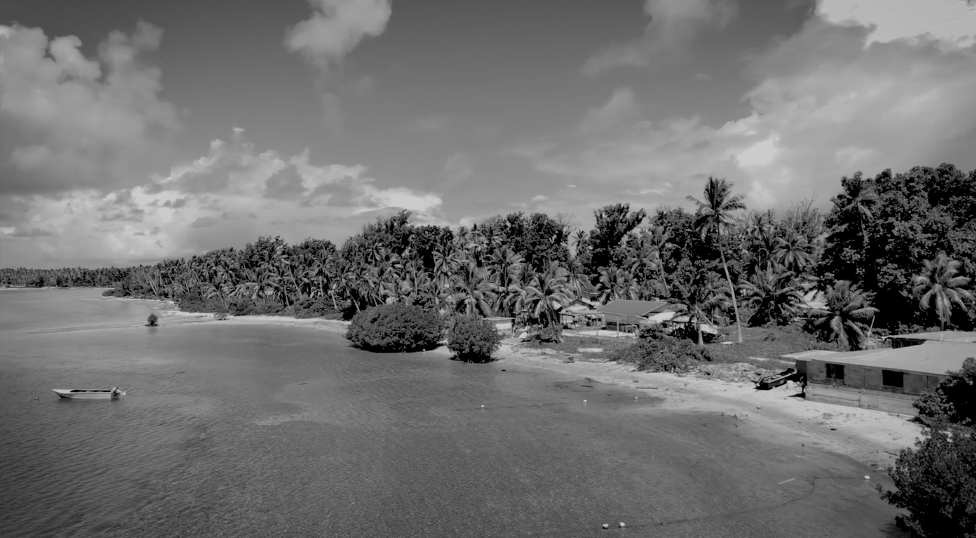
Vailahi Vailahi, Drone Footage of Nanumea and Funafuti (2025)
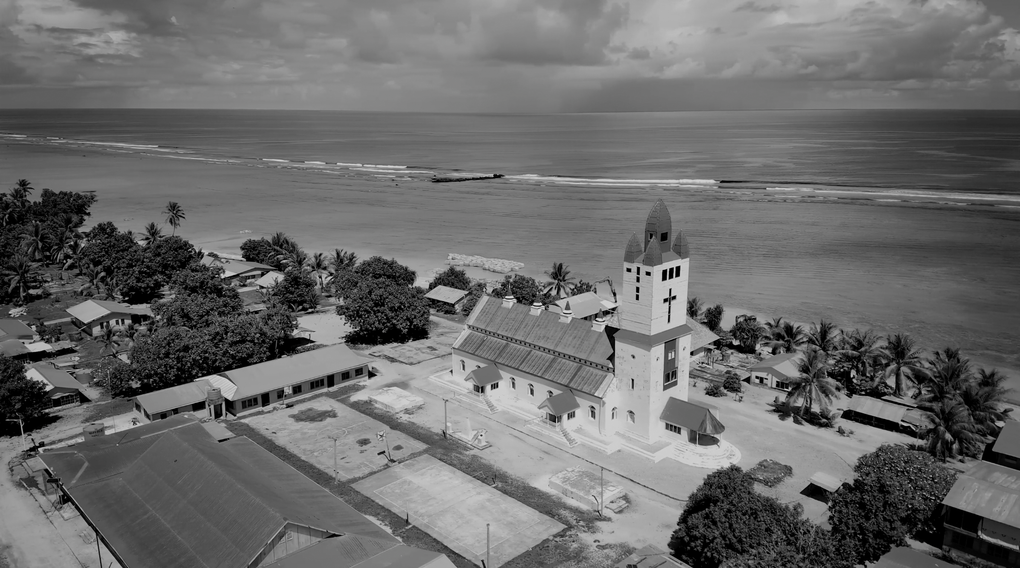
Vailahi Vailahi, Drone Footage of Nanumea and Funafuti (2025)
At the centre of the island, the drone’s camera captures the Aahiga and the Lotolelei Church, key communal sites that, along with surrounding family homes, are repositories of story, song, and language. These spaces are more than architecture; they are living vessels of ceremony, memory, and connection. Though we do not hear these voices in the film, their presence is held in the built environment, and in the rhythm of rooftops and gathering places. Both sites have been digitally scanned by Vailahi using photogrammetry and LiDAR, forming part of an immersive archive that safeguards not only the structures themselves but the stories shared by Nanumean elders. In this work, Nanumea unfolds in concentric layers: shared spaces, family homes, lagoon, reef, ocean. There are no fences; boundaries are defined through relationships, not division. The footage continues across rooftops and communal spaces, rising again to reveal the village ringed by reef. The narrowing landmass, the stretch of horizon, and the encroaching sea all speak to the stakes of environmental loss. In the final scene, the drone begins its descent, slowly returning to land as the horizon slips into cloud. A closing title reads: "Save Tuvalu to Save the Earth." This is a call to shared accountability.
He Whakaputanga Moana
On 28 March 2024, Indigenous leaders from Aotearoa, the Cook Islands, Tahiti, Tonga, Hawai‘i, and Rapanui signed He Whakaputanga Moana (Declaration for the Ocean), a non-binding treaty recognising whales as legal persons with inherent rights, including freedom of movement and the right to a healthy environment.(5) Spearheaded by the Hinemoana Halo Ocean Initiative, the declaration draws on Te Ao Māori and affirms the interconnectedness of all life forms, proposing protections such as marine reserves and rāhui (customary restrictions). It both positions Polynesian communities as kaitiaki (guardians), and recognises Indigenous knowledge as a form of science and technology.
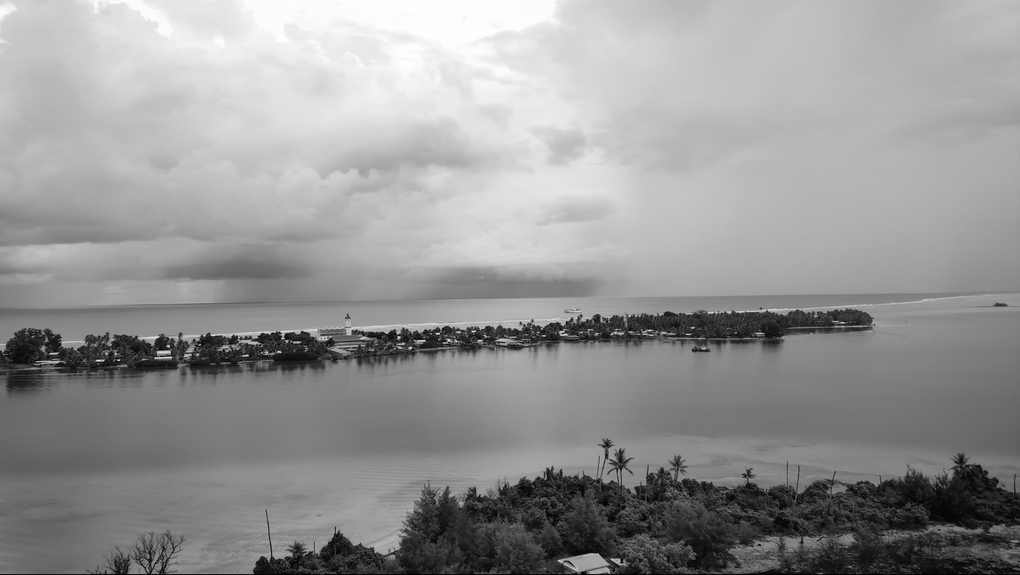
Vailahi Vailahi, Drone footage of Nanumea and Funafuti (2025)
"Without us there is no memory of the beginning, middle, or the end." So writes Audrey Brown-Pereira in her poem 'they taking pictures of us in the water,' resisting the colonial gaze that renders Pacific people as submerged, mythical, and helpless.(6) As a writer of Cook Islands Māori and Samoan descent, Brown-Pereira’s words are a declaration of presence and ancestral authority. The poem has since been remixed into a hip-hop track by producer Faiumu Matthew Salapu (Anonymouz), amplifying its urgency through sound and movement, and which launched as a visual poem at COP28 in 2023 as a call for global action on climate change.(7) Brown-Pereira’s poem, and its transformation into song and moving image, demonstrates the generative power of Pacific orature as a form of climate activism, memory-keeping, and cultural authority.(8) Her words speak from the centre of the ocean, reminding us that Pacific peoples live as relations of land, sea, and sky—remembering, adapting, leading.
In the scientific study 'Wave climate variability and trends in Tuvalu based on a 44-year high-resolution wave hindcast,' analysis of Tuvalu’s wave data reveals how intensifying trade winds and Southern Ocean storms, shaped by global climate cycles, are driving coastal change and flooding, with critical implications for Tuvalu’s future.(9) But studies such as these only affirm what is already felt, observed, and carried through everyday life in Pacific nations. As the impacts of sea level rise intensify, these communities are responding with place-based adaptation, coastal planting, elevated infrastructure, ancestral navigation, and data sovereignty initiatives that enact Indigenous agency. This is He Whakaputanga Moana in action: a declaration of care, continuity, and collective responsibility. Pacific artists are integral to this work; we live and respond to the rhythm and sounds of the ocean. Moving images and creative practice are living archives of ecological shifts, ancestral relationships, and the futures that Tangata Moana continue to imagine and bring into being. Matariki/Mataliki rises on the horizon, guiding us through renewal, resistance, and return. This is the kaupapa of climate action led by ocean peoples: relational, regenerative, and sovereign.
That which is above will fall.
All the islands will unite
And we will stand, and be fortified
— Kapihe
(Kanaka Maoli prophecy from the time of Kamehameha the Great)
Tanya Te Miringa Te Rorarangi Ruka is an artist and CIRCUIT's Kaitiaki Kiriata, a curatorial position which supports a Māori curator to present artists' video in contexts framed by Te Ao Māori. She is the curator of Vailahi Vailahi's project for Masons Screen, Drone Footage of Nanumea and Funafuti (2025).
